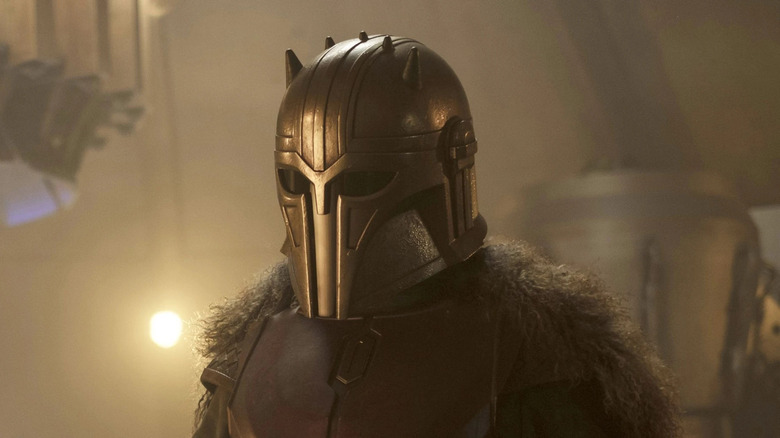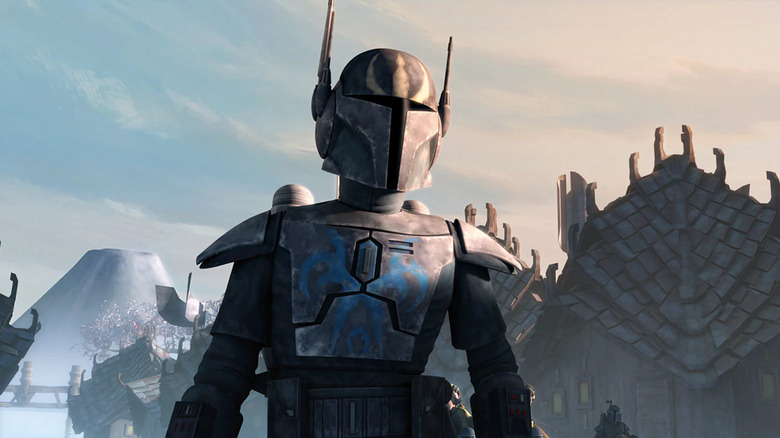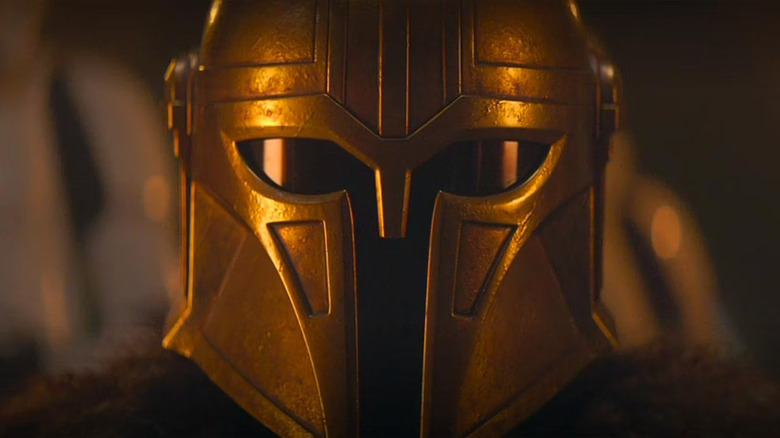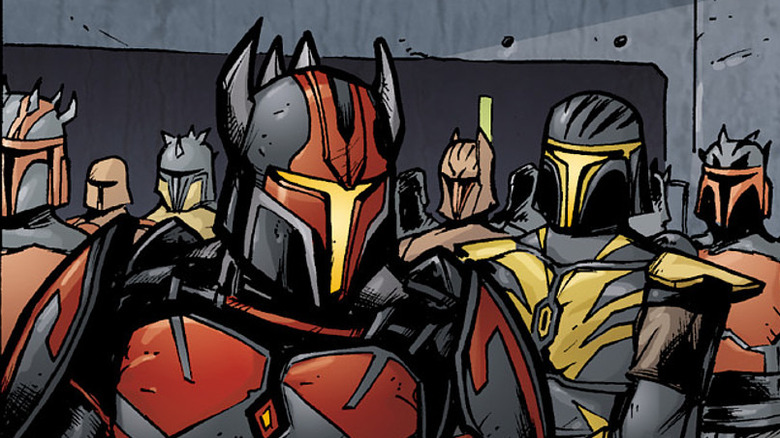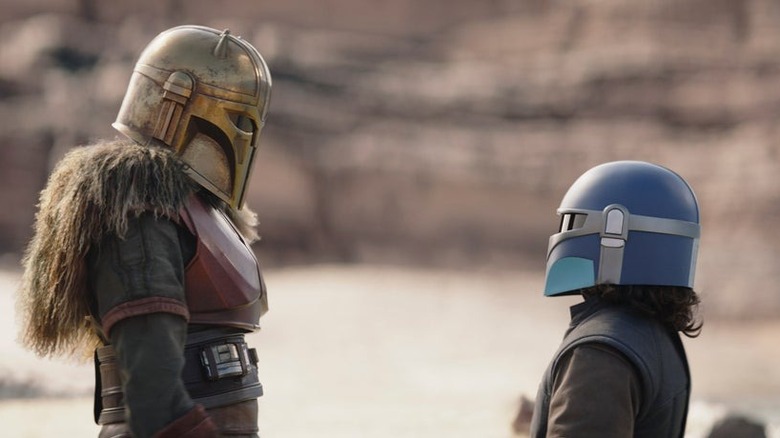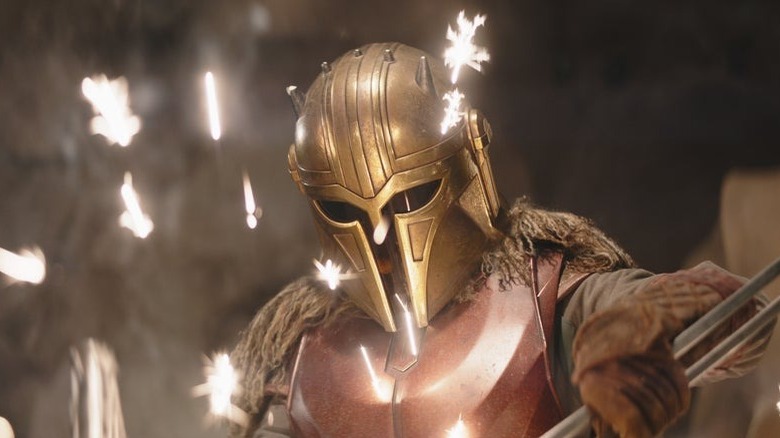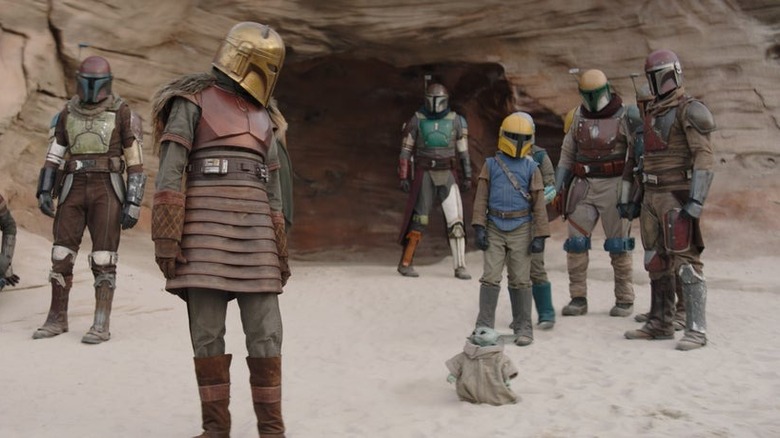Was The Mandalorian's Armorer Ever Part Of Death Watch? An Investigation
"The Mandalorian" season 3 penultimate, episode, "The Spies," finally gathers factions of Mandalorians to retake their home planet of Mandalore. This rattles Moff Gideon (Giancarlo Esposito) because if conflicting Mandalorian factions are organizing instead of remaining divided, then they will be a force to reckon with.
The titular Din Djarin (Pedro Pascal) hails from a significant faction: The Children of the Watch. Throughout "The Mandalorian," he has loyally served the sect that rescued him from a Separatist army on his home planet and raised him on Concordia. He based his virtues on their creed: raise foundlings with care, protect his fellow Mandalorian, and keep his helmet on. As his counselor and chieftain, the cryptic Armorer (Emily Swallow) often tested him on his relationship to his Mandalorian piety, counseled him with answers, and forged his beskar armor and weaponry.
In "The Spies," the Armorer is at the receiving end of an important question that many "The Clone Wars" viewers pondered: Are you Death Watch? The Armorer explains, "Death Watch exists no longer. It shattered into many warring factions." The Armorer's admission implies that the Children of the Watch have a lineage with Death Watch but do not identify with them. This only launched more questions. The first one: But was she ever Death Watch?
Death Watch
Introduced in "The Clone Wars" season 2, Death Watch was a terrorist Mandalorian warrior faction that stirred up political trouble on Mandalore. The then-leader Pre Vizlsa (voiced by Jon Favreau, "The Mandalorian" showrunner) opposes Duchess Satine Kryze (voiced by Anna Graves) and her New Mandalorian campaign for pacifism. As Concordia governor, Pre Vizsla once posed as a valuable ally to Satine while stashing his forces in old mines. Pre Vizsla collaborates with nefarious forces, from the Separatist Count Dooku (voiced by Corey Burton) to the crimelord-cum-Sith Maul (voiced by Sam Witwer), to destabilize the Duchess' reign. If he made Mandalore look weak, Death Watch could play savior and discredit the Duchess.
Bo-Katan (voiced by Katee Sackhoff who reprised her in live-action) was also a Death Watch veteran. But upon watching Maul kill Pre in an honor fight and claim Mandalorian leadership, she and other dissenters rejected Maul's rule. In "The Mandalorian," Bo-Katan makes no explicit reference to the fact that she was Pre's Lieutenant of Death Watch, but she acknowledges the Armorer's comment by noting fractures among Mandalorians.
Back in "The Clone Wars" season 7, Kryze also once told Ahsoka Tano (voiced by Ashley Eckstein), "Don't worry, Death Watch is gone." Bo-Katan may be assuring a Jedi like Ahsoka (who witnessed Bo-Katan's war crimes) that she surrendered her Death Watch ways, while also implying that Pre Vizsla's death fractured Death Watch into sects with transformed identities. We know of Bo-Katan's Nite Owls pitting themselves against Maul's Shadow Collective, but no other major subset has surfaced. Whether the Children of the Watch were born from that particular schism remains ambiguous.
Hypothesis 1: The Armorer wasn't part of Death Watch
There's no clarification if the Armorer was a founding member, nor if the Children of the Watch already existed for several generations. There's some wriggle room in the Armorer's quote: "Death Watch exists no more." She could also be expositing that the Children of the Watch split from Death Watch eons before the Clone Wars. She may have never even been a part of the Death Watch's generation but was educated of her covert's history with them.
"The Book of Boba Fett" reinforces that the Children of the Watch emphasized secrecy. When the Armorer tells Din Djarin of the Night of a Thousand Tears, she credits their secrecy on Concordia as the reason for their survival, implying they didn't participate in Bo-Katan's major campaign (and loss) for Mandalore.
So during the Clone Wars and Satine's regime, it would be consistent with this secrecy that the Children of the Watch remained hidden on Concordia (among its regrowing forests) while Death Watch was executing their own designs on Mandalore. The Children of the Watch would oppose the New Mandalorian government's anti-weaponry and anti-armor, but they might have preferred to stay hidden rather than perform offensive attacks like Death Watch. The Children of the Watch are capable of fighting, but large-scale campaigns would be too costly.
Hypothesis 2: The Armorer was a Death Watch veteran
If the Armorer was a part of Death Watch, she would have had a shared history with Bo-Katan. Not that the Armorer or Bo-Katan would bring it up to each other.
Death Watch would be at odds with the Armorer's current practices. They did not observe constant helmet-wearing like the current Children of the Watch. Before Bo-Katan appeared on "The Mandalorian," Din Djarin's constant helmet-wearing made for initial confusion and speculation for "The Clone Wars" viewers who knew that Death Watch, Pre Vizsla, and Bo-Katan freely doffed their helmets. But it wouldn't be improbable that Death Watch recruited orthodox warriors who practiced constant helmet-wearing.
Some fans linked the Armorer's horned helmet to the horned helmets of Maul's Mandalorian followers as seen in the "Son of Dathomir" Marvel comics, furthering theories that she was a follower of Maul. If she broke away from Death Watch to found her sect, it's not improbable that she may have double-downed on older traditions (maybe out of penance for her Maul worship), including the helmet-wearing. So she founded the Children of the Watch in hopes of replenishing the Mandalorian population. While adoption into Mandalorian culture was nothing new (Legends named this "gai bal manda"), she and her warriors would lean harder into the practice in a galaxy where their warrior culture was waning.
Could the Armorer be a spy?
Bearing a mysterious identity, the Armorer has attracted more theories. Many viewers already see the Armorer as a sketchy leader who dispenses information at her convenience. She never really educated Din Djarin that sinful, unhelmeted Mandalorians existed outside of their circle. And after enforcing her strict helmet-wearing rule, she now permits Bo-Katan, a guest member, to remove her helmet in season 3?
A catalyst for speculation, "The Spies" episode never clarifies who the spies are either. The title's meaning could come from Imperial Elia Kane's reappearance and other unspecified spies, but some hypothesized that the Armorer is the spy. Or the reason might be anticlimactic: "Spies" could refer to Mandalorians becoming spies on their own stolen home planet, or the hidden Imperials surveilling the Mandalorians.
Still, there's something ominous about the stormy sequence following the Armorer as she delivers the injured to the Mandalorian fleet, while the others below head toward the secluded Imperials. (R.I.P. Paz Vizsla.) Some might speculate that she counted on Bo-Katan perishing in battle (sacrificing her own Watch members), so the Armorer may inherit or jockey for power among the Mandalorian fleet (a sort of mirror to Moff Gideon's quest for power in the cold opening). Or maybe it's just an ordinary sequence and director Rick Famuyiwa misdirected our senses, knowing that we had to anticipate an Imperial attack either on ground or in orbit.
We never got real answers about Din Djarin's rescue
"The Mandalorian" season 1 finale raised the brows of a few "Clone Wars" viewers when Din Djarin revealed that Mandalorians rescued him from orphanhood. His Mandalorian rescuers bore a symbol like Death Watch, and fans wondered if Death Watch (or a faction associated with them) rescued Din Djarin. Apparently, the answer was the Children of the Watch.
But fans might see no differences in the extremist groups in "The Mandalorian." Considering Death Watch's past of staging false attacks, many speculate that the Children of the Watch were responsible so they could conveniently recruit orphans or play the savior on another planet. Meaning, they were responsible for the deaths of Din Djarin's parents and village. If that's the twist, that would upend Din Djarin's understanding of his Mandalorian creed. He would never look at his beskar, his Mudhorn clan signet, and Grogu's chainmail and armor the same.
On the other hand, it could easily be explained that the Children of the Watch happened to intervene in a straightforward Separatist attack with no nefarious motives. That said, with military oppression around the galaxy, those Mandalorians might view vulnerable villages as convenient areas to harvest foundlings. Now the Watch's creed does stipulate that Mandalorians must return foundlings to their own kind if they can't practice the Mandalorian Way (Djarin spent season 2 finding Grogu a nice Jedi guardian before Grogu decided he would rather be Mandalorian), but vulnerable villages do increase the chances of the Watch finding loyal foundlings.
Maybe I'm overthinking
Bo-Katan once dismissed the Children of the Watch as a condemnable cult of zealots, and it's unknown if this attitude can be attributed to her extremist past. Season 3 ended up complicating her perspective when she grew to admire their communal bonds. After depicting their nobility, "The Mandalorian" or other "Star Wars" media have an opportunity to tap into the grayer elements of the Watch. For now, it's in the audience's imagination. The upcoming season 3 finale may drop some long-awaited answers about the Armorer — or amplify fans' questions.
If you don't view the Armorer in a sinister light, you might just perceive her as a rounded leader, strict enough to uphold tradition but flexible enough to welcome opposing views. Even her portrayer Emily Swallow thinks so. If you factor in the Armorer's possible Death Watch past, that thickens her shadiness. Though a similar skepticism can be applied to Bo-Katan, viewers of Kryze's cartoon appearances are more acquainted to read her current actions as atonement for her Death Watch past. By comparison, the Armorer is deeper in the shadows. There is too much black and gray to explore. The Armorer would have to bend her principles too far to betray her fellow Mandalorians. But then again, she bent her beliefs before.
